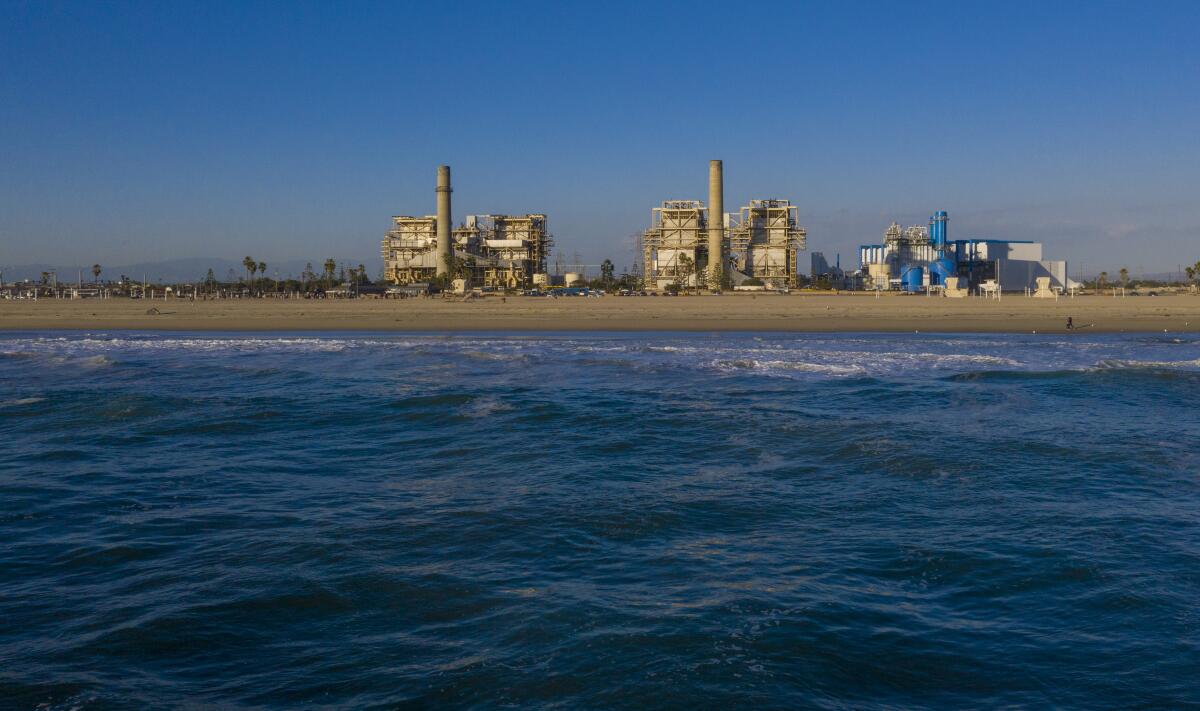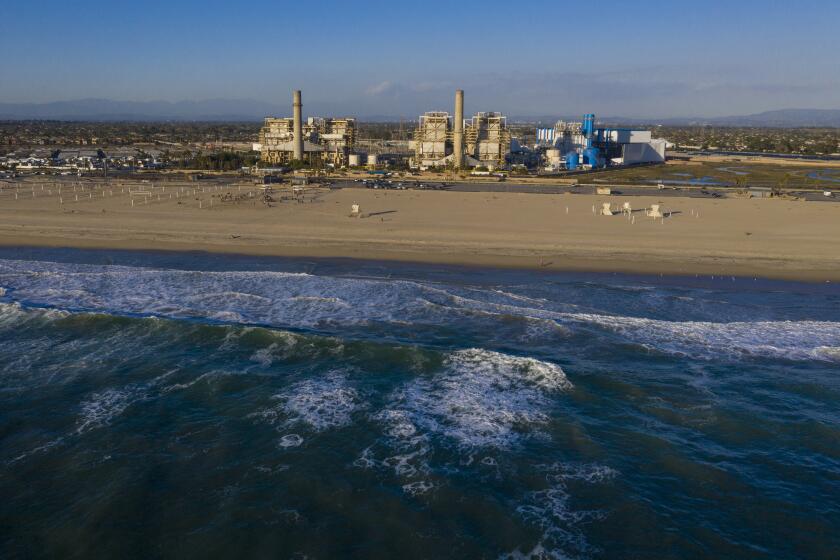Questions linger about environmental impact of Poseidon plant

- Share via
Every year that it converts a bit of the Pacific Ocean into drinking water, the proposed Huntington Beach desalination plant would kill tiny marine life crucial to the sea’s food web.
Questions of how and when to offset that environmental harm remain unresolved in regulators’ ongoing review of Poseidon Water’s plans to build a $1-billion desalting plant on the Orange County coastline.
After a nearly nine-month pause, the Santa Ana Regional Water Quality Control Board last week resumed consideration of the project, which has been clouded by complaints that it is benefiting from political interference by Gov. Gavin Newsom’s administration.
The board reopened its Poseidon proceedings Friday with statements by three members who rejected opponents’ demands that they recuse themselves in the wake of February disclosures that they had been contacted by a high-ranking administration official during project hearings in the summer.
Board Chair Lana Peterson, Vice Chair Kris Murray and member Joe Kerr said Environmental Protection Secretary Jared Blumenfeld had not tried to sway their votes nor discussed details of the proposal in his text messages and phone calls.
Emails reveal that Newsom administration officials and Poseidon Water executives have been heavily involved in a regional water board review of the desalination proposal.
The board’s newest member, Letitia Clark, also said her conversation with a pro-Poseidon labor official during her 2020 reelection campaign to the Tustin City Council was not grounds for recusal.
Clark was appointed by Newsom in October to replace William Von Blasingame, a two-term board veteran who had repeatedly raised concerns about various aspects of the Huntington Beach project.
Von Blasingame’s departure fueled criticism that Newsom is pushing the private water-supply project because of his ties to lobbyist Jason Kinney, whose firm, Axiom Advisors, earned $575,000 representing Poseidon in 2019-20.
The administration has denied any improper meddling and noted that seawater desalination would help diversify California’s water supply.
One of the things Von Blasingame and some other board members pressed for in summer 2020 is a condition barring Poseidon from operating the desalter — and thus selling water — until the company is ready to begin all its required environmental mitigation work.
The state’s focus on fighting fires has some experts asking, “Does California need a new agency to focus on wildfire prevention?”
That issue dominated board discussion during last week’s marathon hearing and will be taken up again Thursday.
Poseidon is fighting the condition, while California Coastal Commission staff say it is the only way to guarantee that required environmental work starts on time.
The company plans to build the desalter on the grounds of the AES Huntington Beach Generating Station, which uses seawater for cooling but will close in the next few years.
Poseidon would screen the power plant’s offshore intake pipe, which is big enough for a tractor-trailer to drive through, and use it to feed the desalter with 106 million gallons a day of seawater.
A reverse osmosis scrubbing process would convert roughly half of that volume into water supplies and half to a super-salty brine that would be dumped back into the ocean via a 1,500-foot discharge pipe equipped with outfall diffusers to promote mixing and dilution.
All told, state scientists say the desalting operation will kill nearly 300,000 microscopic organisms a day, exacting a significant toll on algae, plankton and fish larvae at the base of the marine food web.
“This is an immense impact,” Coastal Commission scientist Tom Luster told the board.
Under pressure from the board, Poseidon has added more environmental work to its mitigation proposal. It now includes dredging of an ocean inlet to the Bolsa Chica wetlands, restoration of Bolsa Chica cordgrass marsh and creation of artificial reef habitat for fish off the Palos Verdes Peninsula.
But Poseidon is vehemently protesting the operating condition, saying it could take years to obtain government approvals to begin all the environmental work, indefinitely delaying the desalter’s start-up.
Citing bank letters, Poseidon Vice President Scott Maloni argued that investors would not buy the project’s bonds if they could not be certain of when the plant would start making money.
“We cannot continue to move forward with the project” under the operating prohibition, he told the board.
But the staff of the Coastal Commission, which must still approve the desalter’s construction in the coastal zone, warned of problems without the condition.
“This is an issue that we at the Coastal Commission have learned the hard way,” Deputy Director Kate Huckelbridge said, referring to her agency’s experience with Poseidon’s first big California desalter, in Carlsbad.
Although the San Diego County plant has been gulping seawater, spitting out brine and killing tiny marine life since 2015, mitigation has yet to begin. The latest target date for groundbreaking on construction of intertidal habitat in San Diego Bay is this fall.
The facility was initially approved before adoption of new state ocean-protection rules that apply to the similarly sized Huntington Beach project.
Coastal Commission staff attributes the delays to a variety of factors — some of which Poseidon could not control — but says the company is partly to blame for the six-year gap between Carlsbad plant operation and environmental restoration.
This is not the first time Poseidon has raised economic objections in its two-decade quest to build the Huntington Beach facility, which would be one of the nation’s largest seawater desalters.
The company took advantage of a provision in state rules that allows desalination plants to use environmentally harmful open ocean intakes if more benign methods — such as subsurface intakes favored by the Coastal Commission — are technically or economically infeasible.
An independent science panel concluded that while technically feasible, the installation of subsurface intakes in Huntington Beach would add at least $1 billion to project costs, rendering the desalter’s output so expensive no water agency would buy it.
“It’s not the board’s job to look out for corporate profits,” said Sean Bothwell, executive director of the California Coastkeeper Alliance, as he urged the panel to retain the mitigation condition on Poseidon’s operating permit.









